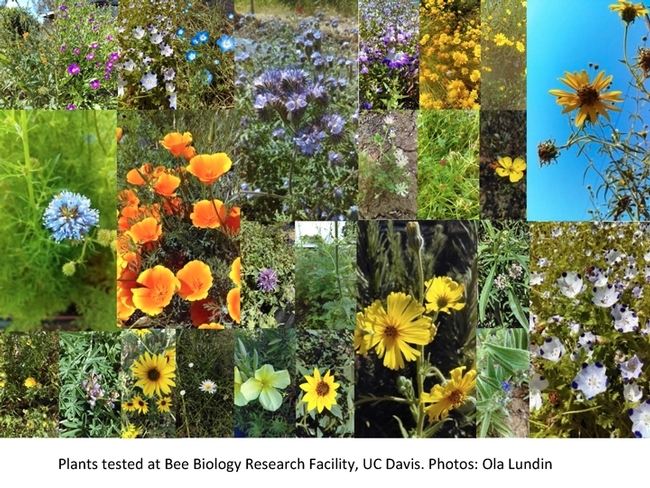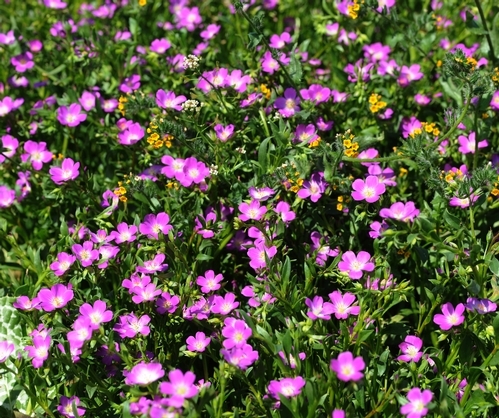
These are the plants they established in a garden on the grounds of the Harry H. Laidlaw Jr. Honey Bee Research Facility at UC Davis.
"The overall aim of our study was to identify California native plants, and more generally plant traits, suitable for coordinated habitat management of arthropod pollinators, herbivores, and natural enemies and promote integrated ecosystem services in agricultural landscapes," they wrote. "More specifically we ask (a) which native plants among our candidate set attract the highest abundances of wild bees, honeybees, herbivores, predators, and parasitic wasps, (b) if the total abundances of arthropods within these functional groups across plant species are related to the peak flowering week, floral area, or flower type of the focal plant species, and (c) if the total abundances of arthropods within these functional groups are correlated to each other across plant species." (See the results of their research.)
How did they select the plants? "Selected species were forbs that were drought-tolerant, native to California (one exception), and as a group, covered a range of flowering periods throughout the season," they wrote. The one exception: Fagopyrum esculentum, or "domestic buckwheat." Although it's a non-native, it was introduced elsewhere but naturalized in the wild.
Their selections were also based on several other factors:
- indications that they could be attractive to bees based on being listed as nectar and pollen plants for honeybees (Vansell, 1941)
- being recommended as pollinator plants (Xerces Society, 2018)
- being listed as associated with bees in Calflora (2017) or based on earlier collected data on bee attractiveness (Williams et al., 2015).
A further criterion that restricted selection was that "plant material needed for propagation be commercially available either as seeds or plug plants." The exception: Antirrhinum cornutum, commonly known as spurred snapdragon, for which seed was hand-collected.
They excluded plants that are major weeds of crops or pastures. They did note, however, that Amsinckia intermedia (Eastwood's fiddleneck) and Calandrinia menziesii (red maids) can be desirable components of wildlands, but become minor weeds in certain situations (UC IPM, 2018).
And now for the 43 plants, as listed in their chart. We alphabetized them and linked them to the Calflora.org site so you can see images of the plants and the common names. Calflora is a self-described nonprofit organization "where you can learn about plants that grow wild in California (both native plants and weeds)."
- Achillea millefolium, common yarrow
- Amsinckia intermedia, Eastwood's fiddleneck
- Antirrhinum cornutum, spurred snapdragon
- Asclepias eriocarpa, Indian milkweed
- Asclepias fascicularis, narrow leaf milkweed
- Calandrinia menziesii, red maids
- Camissoniopsis cheiranthifolia, beach evening-primrose
- Clarkia purpurea, purple clarkia
- Clarkia unguiculata, Woodland clarkia
- Clarkia williamsonii, Fort Miller clarkia
- Collinsia heterophylla, Purple Chinese houses
- Eriophyllum lanatum, common woolly sunflower
- Eschscholzia californica, California poppy
- Fagopyrum esculentum, domestic buckwheat (non-native, introduced elsewhere but naturalized in the wild)
- Lasthenia fremontii, Fremont's goldfields
- Lasthenia glabrata, yellow-rayed goldfields
- Limnanthes alba, white meadowfoam
- Lupinus microcarpus var. densiflorus, chick lupine
- Lupinus succulentus, Arroyo lupine
- Monardella villosa, coyote mint
- Nemophila maculata, five spot
- Nemophila menziesii, baby blue eyes
- Phacelia californica, rock phacelia
- Phacelia campanularia ,desert bells
- Phacelia ciliata, Great valley phacelia
- Phacelia tanacetifolia, tansy leafed phacelia
- Salvia columbariae, chia sage
- Scrophularia californica, California bee plant
- Sphaeralcea ambigua, desert mallow
- Trifolium fucatum, bull clover
- Trifolium gracilentum, pin point clover
- Eriogonum fasciculatum, California buckwheat
- Gilia capitata, blue field gilia
- Grindelia camporum, gum plant or gumweed
- Helianthus annuus, hairy leaved sunflower
- Lupinus formosus, Western lupine
- Malacothrix saxatilis, cliff aster
- Oenothera elata, evening primrose
- Helianthus bolande, Bolander's sunflower
- Helianthus californicus, California sunflower
- Madia elegans,common madia
- Trichostema lanceolatum, vinegarweed
- Heterotheca grandiflora, telegraph weed
When you're thinking of what native California plants to establish in your pollinator garden, this is a great list, thanks to the Williams lab and their collaborators.
And, if you want to learn more about their research, contact lead author Ola Lundin, a former postdoctoral fellow in the Williams lab and now a postdoctoral fellow in the Department of Ecology, Swedish University of Agricultural Sciences, Uppsala. He can be reached at Ola.Lundin@slu.se.
Attached Images:
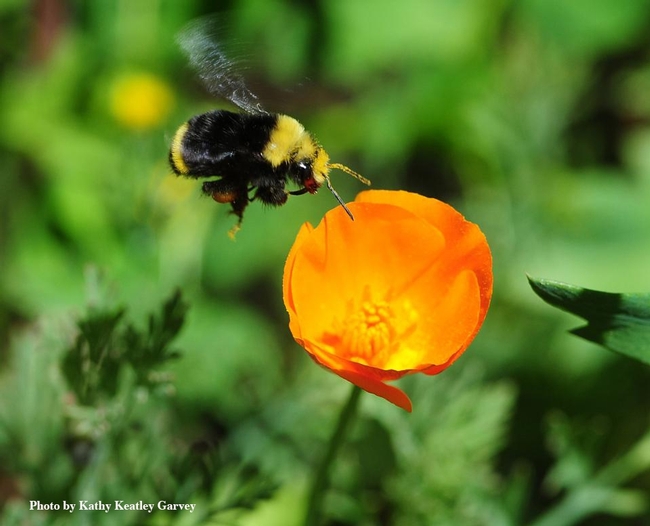
A yellow-faced bumble bee, Bombus vosnesenskii, heading toward California poppy,Eschscholzia californica. (Photo by Kathy Keatley Garvey)
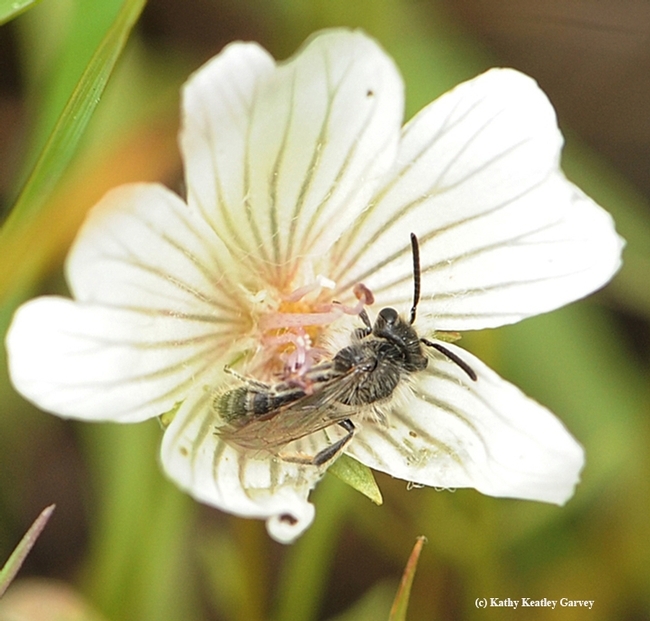
Andrena (mining bee) on meadowfoam, Limnanthes alba. (Photo by Kathy Keatley Garvey)
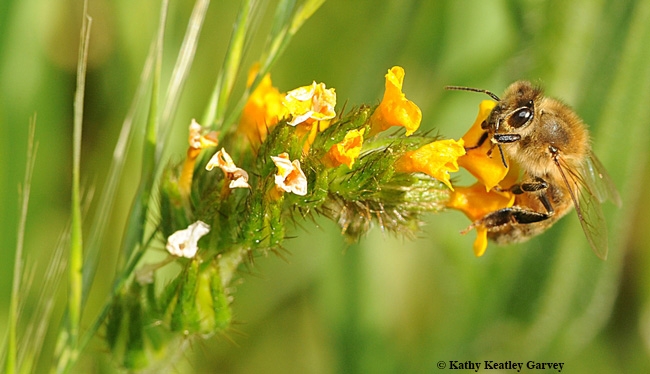
A honey bee, Apis mellifera, on fiddleneck, Amsinckia. (Photo by Kathy Keatley Garvey)
